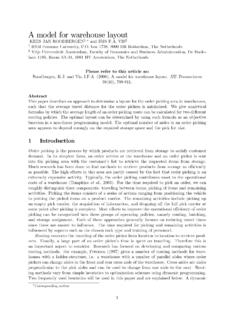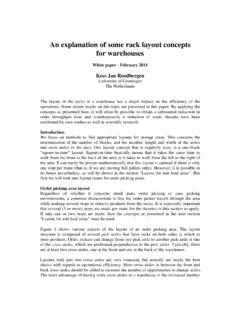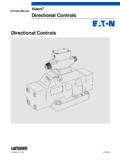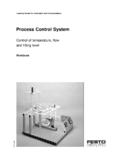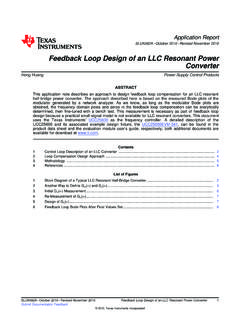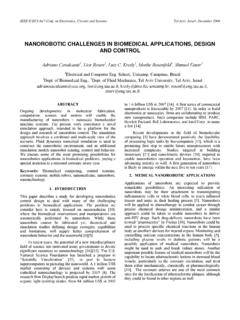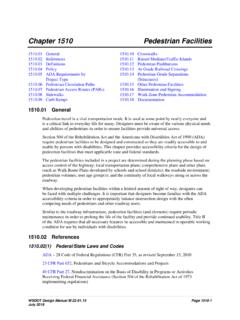Transcription of Design and control of warehouse order picking: a ...
1 1 Design and control of warehouse order picking : a literature review Ren de Koster1, Tho Le-Duc, Kees Jan Roodbergen RSM Erasmus University box 1738, 3000 DR Rotterdam, The Netherlands phone: +31-10-4081719 fax: +31-10-4089014 T Please refer to this article as: De Koster, R., Le-Duc, T., and Roodbergen, (2007), Design and control of warehouse order picking : a literature review. European Journal of Operational Research 182(2), 481-501. 1 corresponding author, 2 Design and control of warehouse order picking : a literature review Abstract order picking has long been identified as the most labour-intensive and costly activity for almost every warehouse ; the cost of order picking is estimated to be as much as 55% of the total warehouse operating expense. Any underperformance in order picking can lead to unsatisfactory service and high operational cost for its warehouse , and consequently for the whole supply chain.
2 In order to operate efficiently, the order - picking process needs to be robustly designed and optimally controlled. This paper gives a literature overview on typical decision problems in Design and control of manual order - picking processes. We focus on optimal (internal) layout Design , storage assignment methods, routing methods, order batching and zoning. The research in this area has grown rapidly recently. Still, combinations of the above areas have hardly been explored. order - picking system developments in practice lead to promising new research directions. Keywords: order picking ; warehouse management; Logistics 1 Introduction As more companies look to cut costs and improve productivity within their warehouses and distribution centres, picking has come under increased scrutiny. order picking - the process of retrieving products from storage (or buffer areas) in response to a specific customer request - is the most labour-intensive operation in warehouses with manual systems, and a very capital-intensive operation in warehouses with automated systems (Goetschalckx and Ashayeri 1989, Drury 1988, Tompkins et al.)
3 2003). For these reasons, warehousing professionals consider order picking as the highest-priority area for productivity improvements. Several recent trends both in manufacturing and distribution have made the order - picking Design and management become more important and complex. In manufacturing, there is a move to smaller lot-sizes, point-of-use delivery, order and product customisation, and cycle time reductions. In distribution logistics, in order to serve customers, companies tend to accept late orders while providing rapid and timely delivery within tight time windows (thus the time available for order picking becomes shorter). Many smaller warehouses are being replaced by fewer large warehouses to realise economies of scale. In these large warehouses, the daily pick volume is large and the available time window is short. In order to be more responsive to customers, many companies have adopted a postponement strategy (Van Hoek 2001) leading to various value-adding activities (like kitting, labelling, product or order assembly, customised packaging or palletisation) that take place in the distribution centre and which have to be scheduled and integrated in the order - picking process.
4 Warehouses are also involved in recovering products, materials, and product carriers from customers in order to redistribute them to other customers, recyclers, and original-equipment manufacturers (De Koster et al., 2002). The organisation of order - picking operations immediately impacts the distribution centre s and thereby the supply chain s performance. Between the time an order is released to the warehouse and the time it takes to reach its destination, there is ample opportunity for errors in both accuracy and completeness, not to mention 3time lost. There is also room for improvement. Industry has come up with innovative solutions, making it possible to attain productivity up to 1,000 picks per person hour. Science is also progressing rapidly. Over the last decades, many papers have appeared studying order picking processes. New problems have been studied and new models have been developed.
5 Still, there is a gap between practice and academic research, since not all new picking methods have been studied and the optimal combinations of layout, storage assignment, order clustering, order release method, picker routing and order accumulation have been addressed to a minor extent only. This paper presents a systematic overview of these recent developments in academic literature. We structure typical decision problems in Design and control of order - picking processes by focusing on optimal (internal) layout Design , storage assignment methods, routing methods, order batching, and zoning. Several areas appear to have received only little attention from researchers. Innovations from practice also lead to new research challenges. The remainder of the paper is organised as follows. In the next section, we briefly highlight warehouse missions and functions and give an overview of order - picking systems.
6 In Sections 3 to 8, we review recent literature on Design and control of order - picking processes, focussing on layout Design , storage assignment, batching, picker routing, and order accumulation. We conclude and discuss potential research directions in Section 8. 2 Warehouses and order picking According to ELA/AT Kearney (2004), warehousing contributed to about 20% of the surveyed companies logistics costs in 2003 (other activities distinguished are value added services, administration, inventory costs, transportation and transport packaging). Warehouses apparently form an important part of a firm s logistics system. They are commonly used for storing or buffering products (raw materials, goods-in-process, finished products) at and between points of origin and points of consumption. The term warehouse is used if the main function is buffering and storage. If additionally distribution is a main function, the term distribution centre is commonly used, whereas transhipment , cross-dock , or platform centre are often used if storage hardly plays a role.
7 As we focus on order picking from inventory, we use the term warehouse throughout the paper. Lambert et al. (1998) state that more than 750,000 warehouse facilities exist worldwide, including state-of-art, professionally managed warehouses, as well as company stockrooms and self-store facilities. Warehouses often involve large investments and operating costs ( cost of land, facility equipment, labour ..). So, why do warehouses exist? According to Lambert et al. (1998) they contribute to a multitude of the company s missions, like Achieving transportation economies ( combine shipment, full-container load). Achieving production economies ( make-to-stock production policy). Taking advantage of quality purchase discounts and forward buys. Supporting the firm s customer service policies. Meeting changing market conditions and uncertainties ( seasonality, demand fluctuations, competition). Overcoming the time and space differences that exist between producers and customers.
8 Accomplishing least total cost logistics commensurate with a desired level of customer service. Supporting the just-in-time programs of suppliers and customers. Providing customers with a mix of products instead of a single product on each order ( consolidation). Providing temporary storage of material to be disposed or recycled ( reverse logistics). Providing a buffer location for trans-shipments ( direct delivery, cross-docking). 4 In some special situations ( lean manufacturing, virtual inventory, cross-docking), storage functions in a supply chain can be reduced. But, in almost all supply chains, raw materials, parts, and product inventories still need to be stored or buffered, implying that warehouses are needed and play a critical role in the companies logistics success. warehouse flows Figure 1 shows the typical functional areas and flows within warehouses. The main warehouse activities include: receiving, transfer and put away, order picking /selection, accumulation/sortation, cross-docking, and shipping.
9 Figure 1 Typical warehouse functions and flows (Tompkins et al. 2003) The receiving activity includes the unloading of products from the transport carrier, updating the inventory record, inspection to find if there is any quantity or quality inconsistency. Transfer and put away involves the transfer of incoming products to storage locations. It may also include repackaging ( full pallets to cases, or standardised bins), and physical movements (from the receiving docks to different functional areas, between these areas, from these areas to the shipping docks). The order picking /selection is the major activity in most warehouses. It involves the process of obtaining a right amount of the right products for a set of customer orders. The accumulation/sortation of picked orders into individual (customer) orders is a necessary activity if the orders have been picked in batches. In such a case the picked units have to be grouped by customer order , upon completion of the pick process.
10 After picking , orders often have to be packed and stacked on the right unit load ( a pallet). Cross-docking is performed when the received products are transferred directly to the shipping docks (short stays or services may be required but little or no order picking is needed). order picking order picking involves the process of clustering and scheduling the customer orders, assigning stock on locations to order lines, releasing orders to the floor, picking the articles from storage locations and the disposal of the picked articles. Customer orders consist of order lines, each line for a unique product or stock keeping unit (SKU), in a certain quantity. In Figure 1, order lines are split, based on quantity and product Reserve storage &pallet pickingCase pickingBroken casepickingShippingCross-dockingDirect put away toreserveDirect put away to primaryReplenishmentReplenishmentReceivi ngFrom suppliersFrom customers (reused, orderedbut not bought by customers)Accumulation, sortationpacking 5carrier of the SKU, in pallet picks, case picks and broken case (unit) picks.

